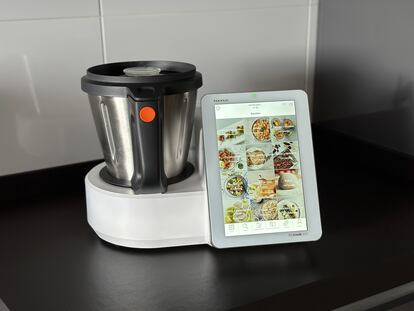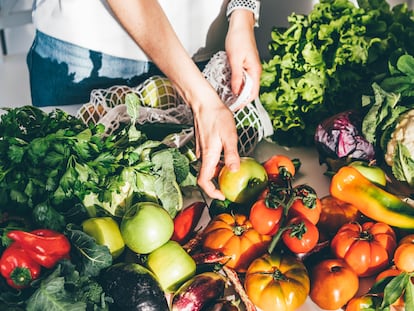What’s on the menu? A food processor to ease the weekly food preparation
An experiment with a food-planner and preparer shows multiple advantages, though there’s still room for the traditional approach

When you don’t know how to cook, it is frequently said that a food processor is your greatest ally: it can help to prepare a stew, a creamy white sauce or a smooth purée. And the truth is that its evolution in recent years has made it easier than ever for anyone to create elaborate recipes without the need for much skill in the kitchen. This is thanks to functions such as guided recipes, which explain what to do step by step via the screen on the device itself, and the automatic adjustment of the temperature, speed and operating time, ensuring nothing goes wrong.
Personally, I have been using one of these devices in my kitchen for years, although I must confess that until now I had done so sporadically and for very specific recipes, particularly those that involve having to continuously stir and knead to avoid the mixture from sticking, as in the case of sauces and dough. But a few weeks ago, I decided to go a step further and make intensive use of the machine, taking advantage of the fact that the ones coming onto the market now are increasingly versatile. I wanted to know if I would be able to base the planning and preparation of the weekly menu for the whole family on one of these devices.
The experiment
I used a Taurus MyCook Next robot, a high-end model that has a free platform — the so-called MyCook club — with more than 20,000 recipes of all kinds and a menu planner. With subtle differences in terms of the number of recipes or planning possibilities, many current robots have these functions, including the all-powerful Thermomix, the popular Lidl robot Monsieur Cuisine and models produced by Moulinex and Cecotec.
The MyCook club, in particular, is accessible both from the device’s large 10-inch screen, which looks like a tablet, and from the browser on a computer or a mobile app, all of which are coordinated.
To search for a specific recipe, it is best to filter by ingredients or cooking style. Its complete search engine allows you to find recipes that contain a particular ingredient — tomato, for example, if that is what needs using up in the fridge; alternatively, if you suffer from an allergy or are following a special diet, ask it to show only recipes without gluten or egg. Each dish includes nutritional information and the cost, plus the time and level of difficulty involved in the preparation, as well as a list of ingredients — next to each is a ‘+’ symbol if you wish to add them to your shopping list. The dish can also be sent directly to the meal planner, which functions as a weekly calendar with breakfast, lunch and dinner options.
The practicalities
Now that its potential has been explained, let’s get down to the nitty gritty.
Was it useful for cooking all week?
Yes, it is perfectly possible to use it for every meal, although for certain aspects of the preparation, you might need to complete the recipes using a frying pan or the oven. In our case, there are three of us at home, one being a two year old, and practically all the food processors have enough capacity to feed our family; for larger families, some models may prove too small.
Have I made better use of the food I had in the fridge?
Without a doubt. Having the weekly menu programmed and knowing exactly what ingredients are going to be needed has meant that I have significantly reduced impulse buying. It has also helped me to take advantage of food that might otherwise be left to go off in the fridge.
Does it use more or less power than a ceramic hob or oven?
As a general rule, these devices are more efficient. To give a specific example, the Taurus robot is one of the most powerful at 2,000 W and, therefore, consumes more; the Thermomix TM6 has 1500 W and Lidl Monsier Cuisine Smart, 1200 W. The glass ceramic and induction hobs consume approximately 2200 W on medium heat; and the oven up to 3500 W. Another potential benefit is that the kitchen robots usually allow for the making of several preparations simultaneously with the use of a steamer etc.
Will I continue to use it?
Yes, but not in the same way. There’s no great advantage to using it for certain dishes and stews once you know how to make them — those involving lentils, for example. In those cases, I’ve gone back to the traditional method. But what I will continue to do is meal planning, using the platform. The benefits of not improvising are multiple — you have a more balanced diet overall, a greater variety of recipes, make better use of ingredients and buy only what you need.
Sign up for our weekly newsletter to get more English-language news coverage from EL PAÍS USA Edition
Tu suscripción se está usando en otro dispositivo
¿Quieres añadir otro usuario a tu suscripción?
Si continúas leyendo en este dispositivo, no se podrá leer en el otro.
FlechaTu suscripción se está usando en otro dispositivo y solo puedes acceder a EL PAÍS desde un dispositivo a la vez.
Si quieres compartir tu cuenta, cambia tu suscripción a la modalidad Premium, así podrás añadir otro usuario. Cada uno accederá con su propia cuenta de email, lo que os permitirá personalizar vuestra experiencia en EL PAÍS.
¿Tienes una suscripción de empresa? Accede aquí para contratar más cuentas.
En el caso de no saber quién está usando tu cuenta, te recomendamos cambiar tu contraseña aquí.
Si decides continuar compartiendo tu cuenta, este mensaje se mostrará en tu dispositivo y en el de la otra persona que está usando tu cuenta de forma indefinida, afectando a tu experiencia de lectura. Puedes consultar aquí los términos y condiciones de la suscripción digital.
More information
Archived In
Últimas noticias
NASA discovers Titan doesn’t have an ocean, but a ‘slushy ice layer’ that increases possibility of life
Innocence lost in the forest of the child soldiers: ‘Each leader of the armed group had his girls’
‘Fallout’ or how the world’s largest company turned an anti-capitalist apocalyptic Western into a phenomenon
From inflation to defending migrants: Eileen Higgins and Zohran Mamdani inaugurate the new Democratic resistance against Trump
Most viewed
- ‘El Limones’ and the growing union disguise of Mexican organized crime
- Christian Louboutin: ‘Young people don’t want to be like their parents. And if their parents wear sneakers, they’re going to look for something else’
- The low-cost creative revolution: How technology is making art accessible to everyone
- ‘We are dying’: Cuba sinks into a health crisis amid medicine shortages and misdiagnosis
- A mountaineer, accused of manslaughter for the death of his partner during a climb: He silenced his phone and refused a helicopter rescue











































